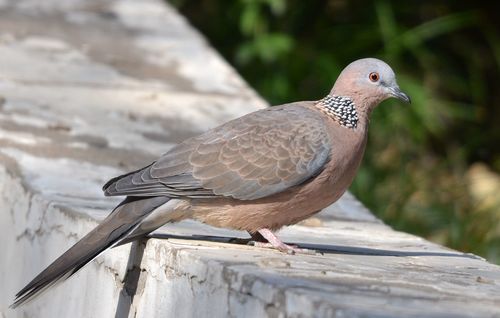
Spotted Dove
The Spotted Dove (*Spilopelia chinensis*) is a widespread and adaptable member of the pigeon and dove family (Columbidae). It is easily recognized by the distinctive black and white spotted patch on the back of its neck. Originally native to South and Southeast Asia, it has been introduced to many other parts of the world, including Australia, the United States, and various Pacific islands. The Spotted Dove plays an important ecological role as a seed disperser and, in some areas, a food source for larger predators. It is often associated with human settlements and agricultural areas.
28-32 cm
Length
40-45 cm
Wingspan
Least Concern
Conservation Status
Distribution
Native to South and Southeast Asia, ranging from Pakistan and India eastward through China and south to Indonesia. Introduced populations are established in Australia, New Zealand, the United States (particularly California and Hawaii), and various islands in the Pacific and Indian Oceans.
Lifespan
Typically 3-5 years in the wild, but can live longer in captivity (up to 10 years or more).
Spotted Dove's Habitat
Habitat Types
Open woodlands, Grasslands, Agricultural areas, Urban and suburban parks, Gardens, Scrublands
Climate Zones
Tropical, Subtropical, Temperate
Adaptations
The Spotted Dove is highly adaptable to human-modified environments. Its ability to thrive in a variety of habitats, including those with significant human disturbance, has contributed to its successful range expansion. It does not have specific physiological adaptations to extreme climates.
Variations
Several subspecies are recognized, differing slightly in size and plumage details. For example, *S. c. suratensis* (found in India) has finer spotting than *S. c. chinensis* (found in China). Island populations may show further variations.
Appearance
Breeding Plumage
No significant difference between breeding and non-breeding plumage.
Seasonal Feather Changes
Minimal seasonal variation; may appear slightly duller after molting.
Sex Based Plumage Differences
Males and females have very similar plumage.
Notable Features
Black and white spotted patch (or 'necklace') on the hindneck., Pinkish-brown head and underparts., Grayish-blue wings and tail with white tips on the outer tail feathers.
Diet and Feeding
Primary Foods
Seeds, Grains, Small fruits, Occasionally insects
Foraging Behavior
Primarily forages on the ground, walking and pecking at seeds and other food items. Often feeds in small groups or pairs.
Specializations
No highly specialized feeding adaptations. Its generalist diet contributes to its adaptability.
Seasonal Diet Variations
Diet may shift slightly depending on seed availability. In agricultural areas, it may consume more cultivated grains during harvest seasons.
Behavior
Social Structure
Often seen in pairs or small flocks. Larger aggregations may occur at feeding sites or roosts.
Communication
Soft, cooing vocalizations ('coo-croo' or 'croo-croo')., Bowing displays during courtship., Wing-clapping during display flights (less common than in some other pigeons).
Migration
Generally non-migratory, but some populations may make local movements in response to food availability or weather conditions.
Territorial or Group Behaviors
Not strongly territorial, but may defend the immediate area around the nest. Often forms loose flocks outside of the breeding season.
Conservation
Threats
Habitat loss (although adaptable to human-modified landscapes), Pesticide exposure in agricultural areas, Predation by introduced predators (e.g., cats) in some areas
Protection Programs
No specific conservation programs are targeted at Spotted Doves due to their widespread distribution and stable population.
Local National Laws
Protected under general bird protection laws in many countries, but may be considered a pest species in some agricultural regions.
Population Trend
Stable
Population Estimates
Global population is very large and not precisely quantified; estimated to be in the millions.
Interesting Facts
The Spotted Dove is also known as the 'Chinese Dove' or 'Mountain Turtle Dove'.
These alternative names reflect its origins and some of its physical characteristics.
It is a symbol of peace and love in some cultures.
Like many doves, it is associated with positive symbolism.
The 'crop milk' fed to young doves is rich in protein and fat.
This specialized food is produced by both male and female parents and is essential for the rapid growth of the chicks.
Faqs about Spotted Dove
Are Spotted Doves aggressive?
Spotted Doves are generally not aggressive towards humans or other bird species, although they may defend their nesting area from other doves.
What should I do if I find an injured Spotted Dove?
Contact a local wildlife rehabilitation center or veterinarian for advice. Do not attempt to care for the bird yourself without proper training and permits. Consult a professional for medical or expert advice.
Can Spotted Doves be kept as pets?
While some dove species are kept as pets, Spotted Doves are generally wild birds. Keeping them may be illegal in some areas, and they are not well-suited to captivity compared to domesticated dove species.
Copyright @ Nature Style Limited. All Rights Reserved.
 English
English